Grown IN Indiana: Bringing farming into classrooms is more than cows, sows and plows
Jillian Ressler remembers sitting in her elementary class looking out the window in the direction of the playground. Like most young children, she could not wait until recess.
As soon as lunch was over and the back doors opened, Ressler was flying through them. But she ran right past the slide and the monkey bars and the swings. Instead, she found herself standing on the edge of a fenced-in area that sits in the center of the triangle formed by the Maconaquah elementary, middle and high schools.
Ressler was mesmerized.
“We were elementary kids and always saw them outside,” said Ressler, now a high school freshman. “We were always so excited to come out and be with them and for our chance to get to work with them someday.”
The “them” in question: Cows.
And Ressler got her wish. She now works with the cows as part of the school's curriculum.

The Maconaquah school system, located just north of Kokomo and not far from the Grissom Joint Air Reserve Base, has a unique program where students operate their own small farm raising cows and calves. That’s right, the middle school students are in charge.
While the Maconaquah set-up may be rare, there's nothing new about bringing agriculture into classrooms across Indiana and turning students into budding farmers.
Whether that’s with livestock, row crops or fruits and vegetables, these programs teach students not just about agriculture but also the food system, natural resources and leadership. Agriculture education today goes beyond just teaching students how to be farmers, it also is helping train a new generation of scientists, technicians and engineers, nutritionists and more.
Grown IN Indiana: We are known as a corn and soy state. But there is much more to farming in Indiana.
There are more than 200 schools across Indiana with chapters through Future Farmers of America, which is a youth agricultural education organization. Tami Ketchen, president for the state group, said the membership for those programs is more than 12,000.
Numerous other school farming programs exist outside FFA, too. But the goal for all of them is to help students grow — pun intended, many teachers said — and to expose students to a new way of learning.
“It gives a great variety to the school day to be able to explore,” Ketchen said. “It’s producing students that not only are there for the industry, but they come out with leadership and other core skills they will gain. That’s the secret sauce on why our students likely will excel coming out of our programs.”
'Our cows are spoiled'
There are a few other schools in Indiana with cows and livestock, but what Maconaquah Schools does is special. It was the third school system in the state to get cattle, according to John Sinnamon, the middle school agriculture teacher. But it now is the only school with a calf-cow operation, he said, or one where they have a permanent herd of cows and are breeding calves.
Maconaquah started with just four cows but now has about 20 cattle on campus. The program is on its second generation of cows bred from its original herd.
“We went from an idea and baby steps, and then boom,” Sinnamon said. “We grew it and started it with just a few feeder cows.”

The program began about eight years ago, when middle schoolers put together a business plan about their interest in starting a cattle farm on campus. The students and school then worked with local farmers to secure some donated cattle, said middle school principal Craig Jernagan.
The fenced-in area where the cows graze was originally the soccer fields, and is “right out their back door.”
The students helped raise money to build a barn to house the cattle on campus five years ago. The school also works with a company to breed the calves — the middle-schoolers learn about the genetics and insemination process and then pick out the semen they want to use based on the animals’ traits.
“All of this is student-led,” Jernagan said. “We even let the students do the research on what type of cattle they wanted based on their temperment, and we bought them locally here in Indiana and have grown it from there.”
Now, the whole community is involved.
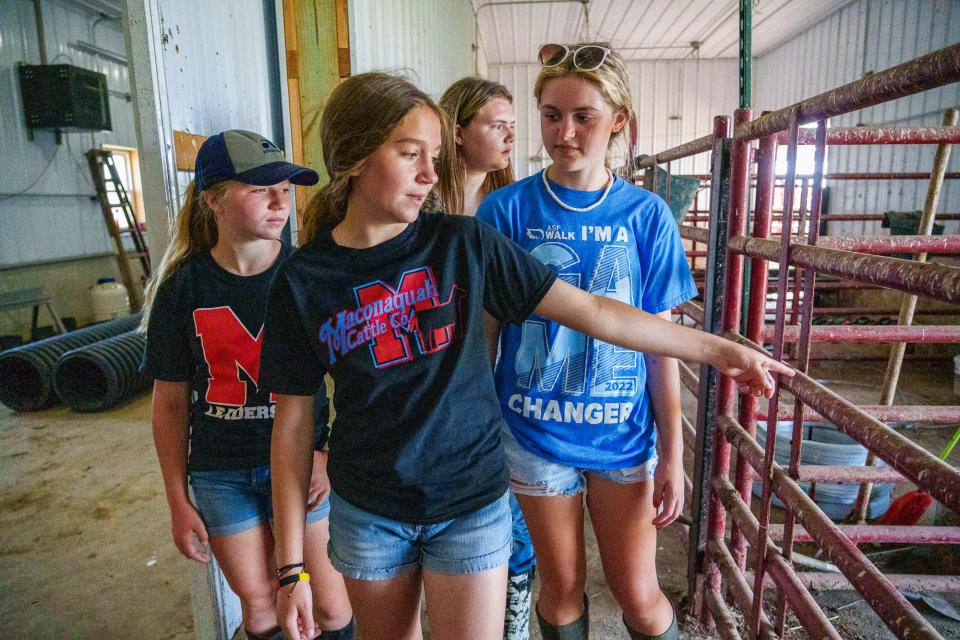
The school board jumped in about three years ago after the program received a grant from the U.S. Department of Agriculture. The leaders bought nearly 50 acres of land behind the school. The land has been planted in about half hay and half corn to help feed the cows. Parents have also chipped in and provided equipment to help with planting and harvesting.
The ultimate goal is to be more self-sufficient and cost-effective by raising additional crops to feed the cows, and to get students more involved on the crop side of things.
Grown IN Indiana: From Indiana to your aquarium, the oldest private fish farm in the U.S. raises goldfish and koi
The students definitely run the show, Sinnamon said, and are incredibly involved in raising the cattle. On their first day of summer break, a handful of students were back on campus to tend to the cows.
Decked in cowboy or rubber boots, jean shorts and t-shirts, Ressler and her friends spent the morning wielding shovels to clean the manure out of the calves’ pens next to the barn. Later in the morning, the sound of feed echoed off five-gallon plastic pails as students filled them up and carried them over to the enclosure.
They scrambled over metal gates as though they were a jungle gym — providing a reminder that they still are children. But they do lots of work and take on a great deal of responsibility.
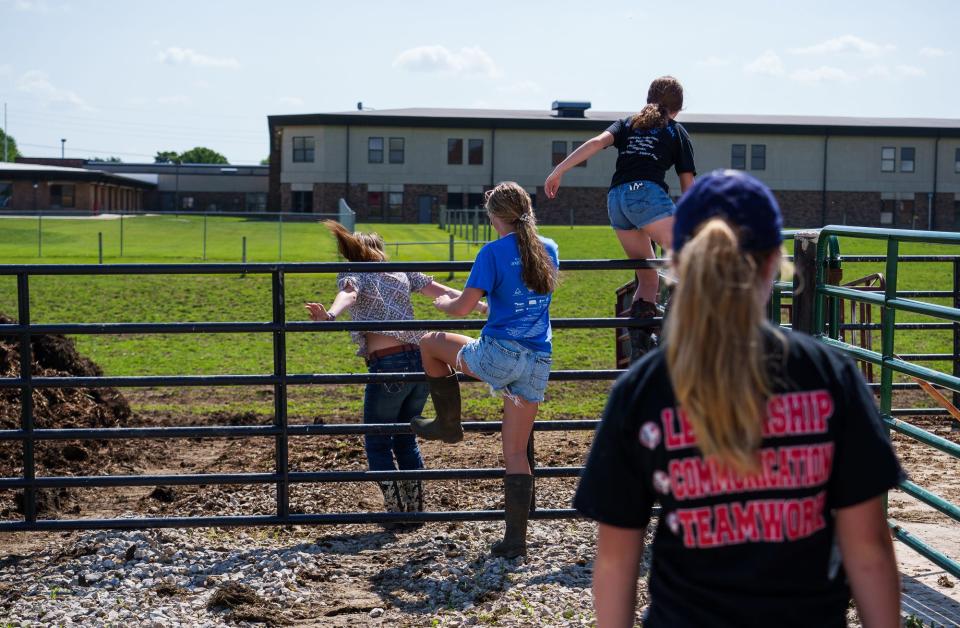
The middle schoolers named this years’ four new calves: Pumpkin, Spice, Latte and Snoop Dogg. Sinnamon, the teacher, added “our cows are spoiled."
“We need to feed the cows and clean up after them, that’s things that are important for them,” said Bayla Gochenour, now a freshman at the high school. “This is something we know we need to do to get the fun time to hang out with the cows.”
Bring the farm into the classroom
While Maconaquah’s program is unique, it is far from the only school in Indiana that incorporates agriculture into its curriculum. It’s happening in multiple places in a variety of different ways.
At White River Valley Schools in southern Indiana, students raise chickens for their eggs, grow flowers in a greenhouse and even have a hydroponics program growing vegetables.
A school system north of Lafayette is working with Purdue University to create small indoor vertical systems to grow produce in a few classrooms.
An Indianapolis school has a hoop house with several raised beds where students grow vegetables, greens, herbs and more for much of the year.
No matter the growing method, much of what’s produced on these school "farms" ends up in the cafeteria and, ultimately, in the bellies of the students. That includes one or two cows each year from Maconaquah, which are sent to be processed and then are served as hamburgers.
Vegetables from White River Valley schools’ hydroponics system have been cooked up, fruit blitzed into smoothies and extra tomatoes made into salsa.
And at the Orchard School in Indianapolis, much of what the students grow stocks the lunchtime salad bar. While they don’t produce enough to feed all students every day, the goal is to supply food for one day each month.
“We use the hoop house because it extends our growing season significantly,” said Victoria Prusinski, the outdoor education coordinator at the Orchard School near Holliday Park. “The goal of the hoop house is to integrate gardening, service and food all into the curriculum.”
The curriculum component is key for many of these schools and is what makes the farming programs special for students.
When Maconaquah began its cattle program, the middle school didn’t have any agriculture classes. Now the cattle class is always full, Jernagan said. Over half of the seventh and eighth graders sign up “because they love working with the cattle above all else,” he said.
Beyond the focused agriculture classes, farming has its place in a variety of subjects. A fourth-grade science lesson at Orchard School sprouted corn, sunflower and bean seeds in the classroom to discuss how things grow. Students then transplanted the sprouts in soil.
“How great is it to plant a seed and watch it grow, it’s so cool and you feel very rewarded,” said Orchard fourth-grader Truman Smith. “It’s interesting to wonder if this is going to go fast or slow and ask what it is going to need.”
The hands-on science "is so cool,” Smith said. “I don’t know how other people find it boring.”
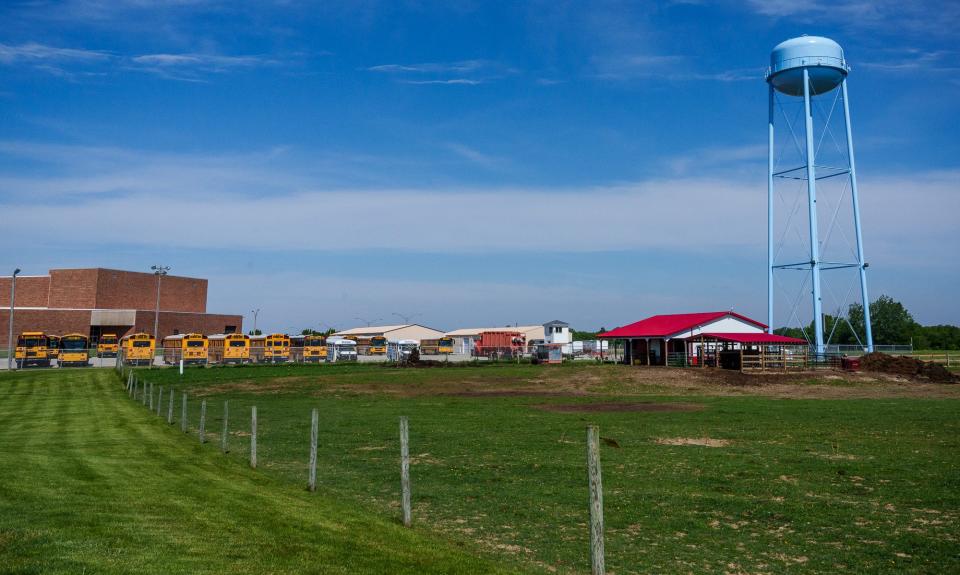
Agriculture also is working its way into math classes. At Maconaquah, math helped students determine how many posts and spools of wire were needed for the fence around the cow’s pasture. And at Orchard School, the math students helped figure out what size the new growing beds should be to maximize space in the hoop house.
Accounting also comes into play at White River Valley Schools where students sell their offerings — including flowers, eggs, welding services on farm equipment, etc. — to the community. Those funds go back into helping grow the program.
Grown IN Indiana: Scaling up, vertical farming takes hold and grows big in Indiana
The produce has been used in language classes to prepare dishes from a particular country and culture. The farming programs have even been integrated into English classes, with students preparing reports and presentations about the work they’ve been doing.
“Today’s agriculture programs are way beyond just cows, sows and plows. Yes, learning production skills is important, that is the foundation of agriculture and our economy … but when a student comes through an ag program, they pick up skills that are going to benefit them no matter what field they go into,” said Sam Zuckschwerdt, White River Valley’s ag educator. “No other program provides students with a wider array of opportunities.”
All the schools are working to involve students at a variety of ages from very young through to when they exit the school system. Maconaquah Superintendent James Callane said the district is working to expand the cattle program to elementary school students. At Orchard School they have students as young as preschoolers, who worked to plant potatoes soon before the summer holiday.
One young student in a dress with strawberries — dressed for the occasion — said as she was patting the soil down to cover the potato plant: “It’s gone, and now it’s going to grow.”
'It just tastes better'
Even outside the classroom, the students put in the work to make sure the operations thrive and that the programs are actually producing and functioning farms.
That includes cleaning out the cow pens at Maconaquah: “We don’t have to do it, we want to do it,” said eighth-grader Anna Lorenz. “We want to learn how to care for them.”

That also means helping to shovel a mixture of soil and manure fertilizer to fill the beds in the hoop house at the Orchard School: “That is st-in-ky,” one of the young students with no filter said, making sure to enunciate every syllable. Still, they jumped in with a bucket and a smile to do the work, knowing it’s a crucial step to being able to grow.
Many of the students spend much of their personal time “on the farm.” At Orchard school, students will use their spare period to work in the hoop house. There's also a Garden Club that focuses on tending to the beds and what’s been planted.
And at Maconaquah, the barn and pasture’s close proximity allows students access to the cows as much as possible throughout the day — before classes start in the morning, during lunch and breaks and before heading home after school. It wouldn’t be the same if students had to travel to get to the farm, said Bailey Ropes, the communications director at Maconaquah Schools.
Ropes said her daughter is one of those students who always runs out to check on the cows before sports practices.
“I got my daughter Carhartt overalls and a jacket so that she could be out there,” Ropes said, “because all the kids want to do it.”
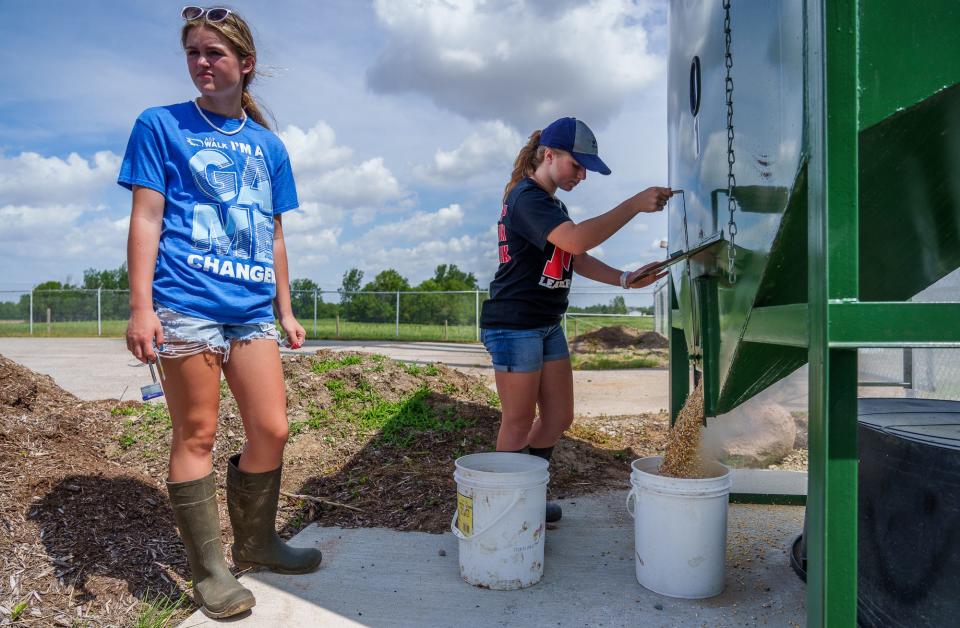
Teachers say the benefits of the programs extend far outside the classroom. They teach students responsibility for the work they are doing, with some even volunteering time on weekends, holidays or summer break.
The programs also build confidence that students can take home to help to start a garden or take care of the animals. Ten-year-old Truman Smith at Orchard School said his family now has a garden where they grow squash, zucchini, peppers, carrots, mint and more. He helped spearhead the family project.
And more than anything, the classes create a sense of ownership in what the students are growing. The students at Maconaquah said while they really care about the cows, they also appreciate the days when hamburgers from their farm are served.
“It just tastes better," said freshman Lane Hunt, "knowing where it came from.”
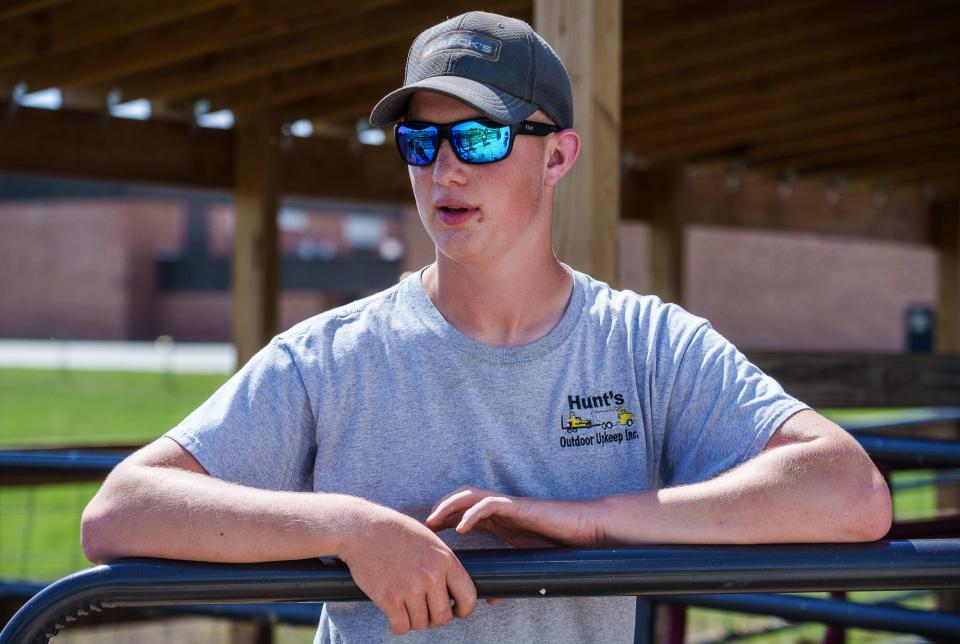
Prusinski said the same is true at Orchard. The kids may not eat spinach when it’s from the grocery store, but they will pluck a leaf off from the garden and taste it or pull out a radish and want to try it.
“It’s fun to watch the kids, it’s like they are going on a safari trying to find a cucumber and just being part of the harvesting process,” the agriculture educator said. “The discovery and the connection of growing something, there is definite ownership and they will say ‘this is my garden bed’ or ‘look at our spinach.’”
Call IndyStar reporter Sarah Bowman at 317-444-6129 or email at sarah.bowman@indystar.com. Follow her on Twitter and Facebook: @IndyStarSarah. Connect with IndyStar’s environmental reporters: Join The Scrub on Facebook.
IndyStar's environmental reporting project is made possible through the generous support of the nonprofit Nina Mason Pulliam Charitable Trust.
This article originally appeared on Indianapolis Star: Indiana students run cattle farm, grow veggies for lunch, fix tractors

